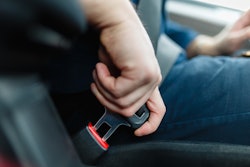Although December is National Impaired Driving Prevention Month, being on the lookout for impaired drivers is a year round necessity. Unfortunately, the prevalence of such run-ins appears to be increasing. The National Highway Transportation Safety Administration (NHTSA) estimates that 13,384 people died in drunk driving crashes in 2021, a 14% increase compared to 2020.
It’s more difficult to measure how many crashes are due to drug-impaired driving, as a good roadside test for it doesn’t exist yet. However, the pervasiveness of taking opioids, marijuana, and even certain prescription drugs when behind the wheel can all lead to reduced coordination, concentration, and reaction times. Drowsy driving can also fall into the impaired driver category. According to the Sleep Foundation, after 20 hours of being awake, drowsy drivers are comparably impaired to someone with a blood alcohol content level of 0.08%, which is the current legal limit in most states. On a more positive front, ride-sharing apps have reduced alcohol-related traffic fatalities by over 6%.
But what can fleet managers do in the face of impairment on the road? And what tools do they need to communicate with their drivers?
Through my 20-plus-year career in professional safety, I’ve found that the solution is three-fold: 1) coach for defensive driving skills 2) promote general driver wellness and 3) find ways to share best practices to a fleet through a variety of mechanisms.
Defensive driving techniques for your drivers
A 360-degree approach to defensive driving can cover most instances of encounters with impaired drivers. Drivers should monitor their forward lane position as well as their side and rear for vehicles that aren’t maintaining lanes, those that are aggressively changing lanes, and those that have inconsistent braking or speeds.
Once an impaired motorist has been identified, drivers should:
1. Keep the driver in front of them to avoid being swerved into or hit from behind.
2. Find additional safe space by reducing speed.
3. Safely change lanes to create additional space.
4. Consider alerting other drivers by activating hazard lights.
Most importantly, drivers should always try to anticipate other drivers’ actions. Chain reactions of incidents from other motorists who are responding to an impaired driver can often lead to bigger collisions.
Technology can also support drivers who come across impaired drivers. With cloud-connected dash cams, for example, drivers can proactively capture events that help protect both the driver and the company. These tools and techniques give fleet managers and safety team members an open avenue to reinforce good defensive driving techniques that are captured along with the opportunity to teach new ones.
Ways for drivers to maintain wellness behind the wheel
General wellness extends to every driver on the road. I like to think of commercial driver licensed (CDL) drivers as industrial athletes, and with that comes the responsibility of keeping themselves safe and healthy.
This includes:
1. Sleep routine and quality sleep, including keeping a regular sleep schedule when possible
2. Proper nutrition with well-balanced diet, avoiding heavy carbs and sugars
3. Adequate hydration
4. Regular exercise and stretching
5. Awareness of what goes into our bodies (such as medication side effects, or using someone else’s medication without knowing the effects, etc.)
Fleet managers can help drivers maintain their health by using ELD compliance solutions to ensure drivers are not pushing through daily working limits that may impair safe operation of a commercial vehicle. Managers can also remain aware of all driver locations and even their general well-being with fleet tracking technology. In one incident, a Lytx customer and driver in the City of North Miami Public Works was reported missing. Thanks to the use of this technology, the driver was identified as unconscious behind the wheel. His fleet manager was able to quickly pinpoint where the driver was and send emergency services to respond to the unconscious driver. The swift action likely saved a life.
Share techniques and best practices widely in your organization
As with most education, awareness is only the first step. Putting learned ideas and concepts into practice is often a challenge for fleets as every driver and company operates differently. Communicating these best practices regularly and through the right mediums can truly save lives and keep fleets running smoothly.
I’ve seen some of these ideas work well to help maintain awareness of defensive driving skills and general wellness tips within an organization:
1. Email newsletters
2. Dispatch sharing Safety Tip of the Day (during safe-stop interaction)
3. Inserts that go inside the envelope of driver’s checks
4. General signage and posters in your facility
5. Main topic in your daily/weekly and/or monthly safety meeting
6. Event videos that showcase fellow drivers’ defensive driving techniques
7. Direct mail flyers to driver’s residences for those who primarily work off-site
8. Video messages from leadership about the importance of wellness and defensive driving skills
9. In-cab OBA’s (Observation Behavioral Assessments) when possible
It’s also highly valuable to create and sustain regularly occurring campaigns that cover safety topics depending on time of year, theme, etc. These can occur monthly, quarterly, or whatever works best for your organization. Getting senior leadership involved to reinforce policies and the company’s dedication to safety can also go a long way in establishing the importance of the topic at hand and help cut through the noise so your drivers fully intake the information.
Safety is everyone’s concern when it comes to handling impaired drivers. Fleets must maintain healthy and aware drivers, practice and “sharpen the saw” with defensive driving skills and share these best practices broadly so every driver is equipped with the right knowledge in their playbook.












